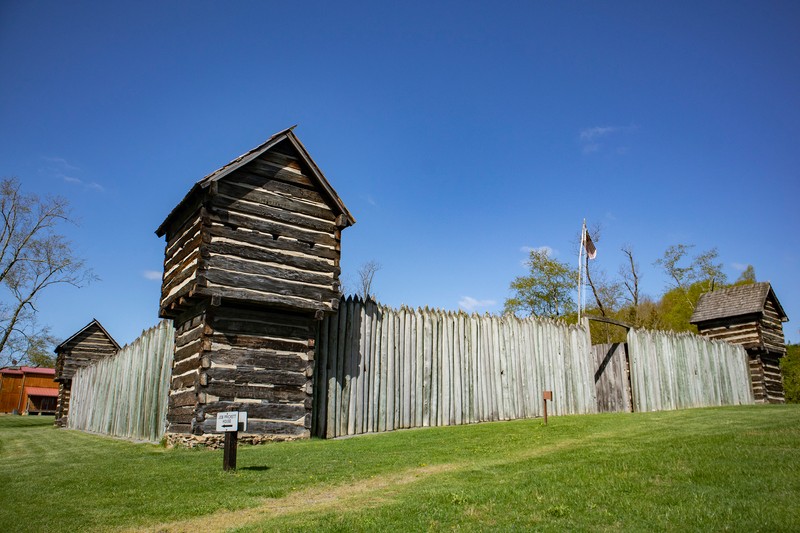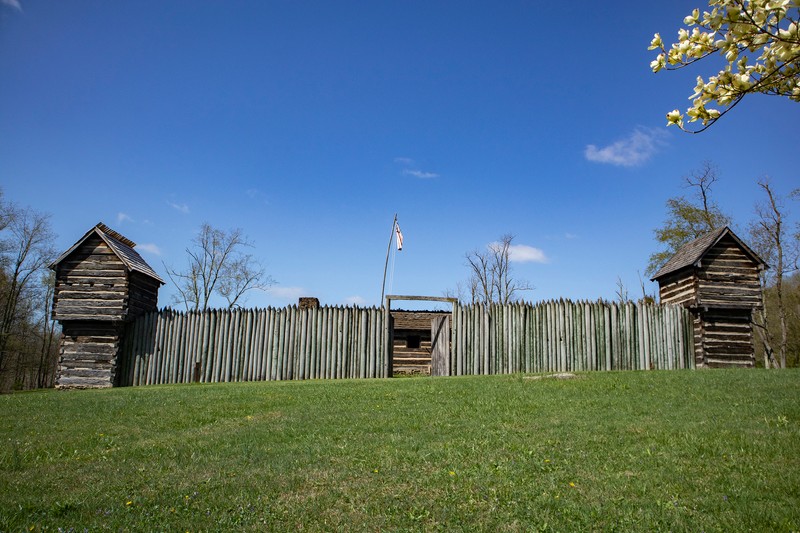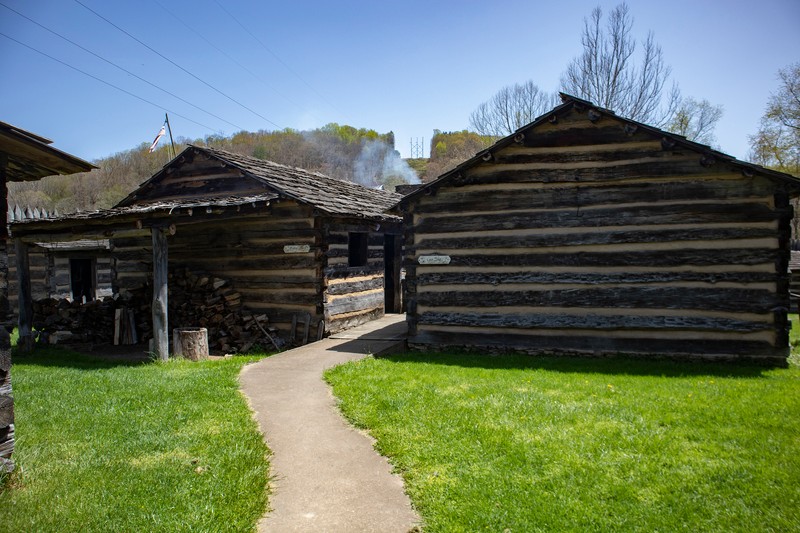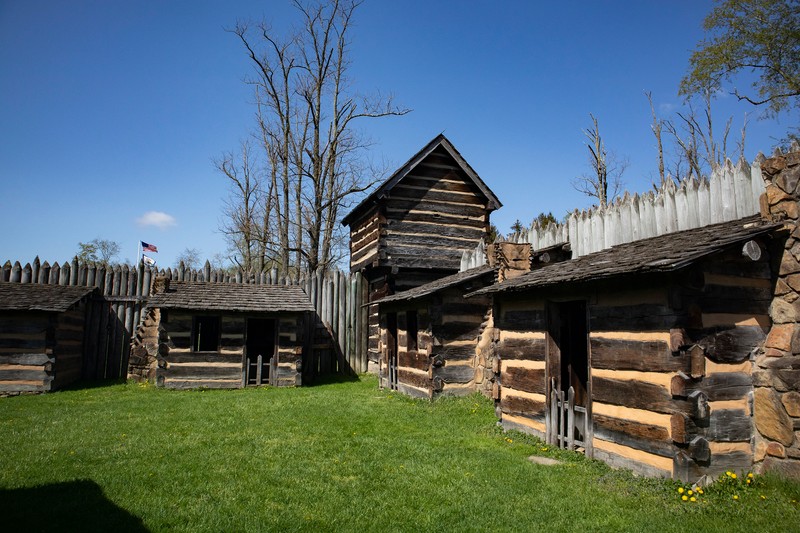Pricketts Fort
Introduction
Text-to-speech Audio
The reconstructed Pricketts Fort is the centerpiece of the historic site. The original fort was constructed in 1774, amid a rise in violence between settlers and Indigenous people on the Virginia frontier. Cayuga war leader Logan led a series of raids to seek justice for his family members who were murdered in the Yellow Creek Massacre in present-day Hancock County. Jacob Prickett, along with Captain Zackquill Morgan and Lieutenant James Chew, formed a militia to defend the region, constructing a stockade fort at the Prickett homestead. In the event of an attack, the fort provided refuge for settlers within a 17-mile radius. During Dunmore’s War and the Revolutionary War, up to 200-250 people could have “forted up” at Pricketts Fort. The fort became obsolete after the Revolutionary War, and was dismantled shortly after. The current fort was reconstructed from October 1974 - June 1976 by the Pricketts Fort Memorial Foundation.
Images
The fort was reconstructed in 1974-1976 in the vicinity of the original fort.


The Trading Post and Meeting House and used to interpret life on the western Virginia frontier.

Blockhouses stored supplies and would have been used as lookouts by the militia. Small cabins provided shelter for civilians seeking refuge or militia members stationed at the fort.

Backstory and Context
Text-to-speech Audio
Pricketts Fort is an example of a stockade fort that was used on the Virginia frontier to provide shelter for area settlers. Unlike military forts, like Fort Pitt at present-day Pittsburgh, Pricketts Fort was privately owned and operated for civilian use. By the end of the Revolutionary War, over two dozen stockade forts, blockhouses, and fortified cabins were built in present-day Marion, Monongalia, Harrison, Taylor, and Preston Counties. The prevalence of these fortifications signifies the intensity of conflict between white settlers and Indigenous people in the upper Ohio Valley.
The Prickett family settled at Pricketts Creek in February 1772, one of about 80 settler families in a 17-mile radius. At the time, what is now West Virginia was a less populated, more remote part of the colony of Virginia. Following the 1768 Treaty of Fort Stanwix, the Iroquois Six Nations transferred land to the colony of Virginia to permit colonial settlement. However, the Shawnee disagreed with the transfer and claimed this land as part of their ancestral homelands. As more white settlers migrated west, Shawnee who were using the land for hunting, gathering, and traveling were increasingly targets of harassment and violence. The Shawnee began organizing other indigenous tribes to defend the region.
These tensions became a crisis on April 30, 1774, when the Yellow Creek Massacre occurred. In present-day Hancock County, West Virginia, located on the northern panhandle between Pennsylvania and Ohio, there were rumors among settlers that a Native American attack was imminent. John Connolly at Fort Pitt sent word for nearby settlements to be on alert. Local hunter and scout Daniel Greathouse led a group of men to ambush a peaceful Mingo camp near Yellow Creek. While details of accounts differ, this premeditated attack led to the deaths of at least eight Mingos. Among those who died were relatives of Logan, a Cayuga orator and war leader. To Logan, the Yellow Creek Massacre was not only personally devastating but also a betrayal of the friendly relations he had maintained with white settlers of the Ohio Country. In response, Logan sought justice for the deaths of his family members by leading a series of raids in the Ohio Country.
The events at Yellow Creek sparked Dunmore’s War, a conflict between the Colony of Virginia and the Shawnee and Mingo over increasing violence in the Ohio Country. Colonial governor of Virginia, Lord Dunmore, authorized funds to support militia forces and an expedition to the Ohio Valley, including the Pittsburgh area, which Virginia claimed at the time to be part of its colony. While the military planned retaliation, settlers also took action, either by fleeing to safety in the east or staying in place to establish defensive strategies. Jacob Prickett and his family were among those who stayed behind. Many families from the area gathered at the Pricketts, finding safety in numbers.
Concerned that an attack was imminent, Prickett and other locals assembled a militia. The militia was under the command of Captain Zackquill Morgan, the founder of Morgantown, and Lieutenant James Chew. Prickett, Morgan, and Chew had been acquaintances since 1764 when they served in the Frederick County militia. They mustered the militia around May 13, 1774, initially with about 45 men. By June, the militia totaled 96 members. One of the militia’s first tasks was to build a fort, which was likely completed by July 1774, to provide shelter for settlers in the region.
Dunmore’s War, from May to October 1774, was a violent time for the Ohio Country, with raids on both white and Indigenous settlements becoming more frequent and brutal. The war ended with the Battle of Point Pleasant in October 1774, though this defeat did not resolve the conflicts entirely. The Revolutionary War quickly followed, with conflicts between white settlers and Indigenous people remaining the central issue for those on the Virginia frontier. Many tribes, including the Shawnee, allied with the British. The increased use of forts and presence of militias on the frontier reflects how Americans sought to hold the land from both Indigenous people and the British Empire during the Revolutionary War.
Pricketts Fort was a privately owned civilian fort, unlike others that were owned and operated by the military. The exact design of the fort is unknown. The current reconstruction is based on designs from other forts in the region and family tradition from Jacob’s great-great-grandson, J. Miles Prickett, who described a stockade with two log houses inside. Approximately 50 families lived within a 5-mile radius of the fort, and 80 families (around 400 people) lived up to 17-mile radius. These families would “fort up” in times of danger. The militias would patrol the countryside. In the event of a possible attack, runners would be sent to the scattered homesteads to warn settlers to “fort up” at Pricketts Fort. Settlers would gather what belongings they could with the time they had, which could include food, clothing, blankets, personal valuables, and sometimes farm animals. Some families stayed for short periods, while others remained for months. Depending on their length of stay, they might return to check on crops and cabins. Most conflicts between settlers and Indigenous people occurred in warmer months because it was an easier time to travel. The harsh cold and snow of winter actually provided a welcome respite for both parties.
During the Revolutionary War, militias from Pricketts Fort aided in larger campaigns. In 1777, for example, they joined the Monongalia County militia led by the recently promoted Zackquill Morgan to put down a loyalist uprising. The only known instance of a militia occupying Pricketts Fort in the winter was between 1777-1778, when General Edward Hand of Fort Pitt stationed militias in each frontier county after the loyalist uprising dispersed forces. Pricketts Fort was not attacked during Dunmore’s War or the Revolutionary War. One of the last documented incidents at Pricketts Fort occurred in May 1779. A settler family was threatened by Native Americans, one of whom was stabbed and escaped. Men from Pricketts Fort tracked down the injured man and brutally murdered him, skinning and tanning his body like an animal. Records of Pricketts Fort end in 1780; no militia records, pension applications, or anecdotal accounts reference Pricketts Fort at the end of the American Revolution. The fort gradually fell into disuse and became obsolete after defeat of the Shawnee at the Battle of Fallen Timbers.
Around the turn of the 19th century, the fort was dismantled. Members of the Prickett family parceled off the acres to descendants and extended families over the next century. The homestead around the original fort belonged to Job Prickett, great-great-grandson of Jacob and Dorothy, and the stately brick farmhouse was passed through family members until the 1950s. After the West Virginia Department of Natural Resources leased the land as a state park, the Pricketts Fort Memorial Foundation was formed to advocate for the site’s historic preservation and spearhead plans to reconstruct the fort. The Foundation first came to an agreement with the DNR and the U.S. Army Corps of Engineers, which owned the land, in 1971.
While the exact original design of the fort is not known, the reconstructed fort draws from various sources and studies of other forts and buildings from the 18th century. The Marion County Historical Society visited a number of regional historic or reconstructed sites to understand period design, including the Jacob Prickett, Jr., house built in 1781, the Musgrave cabin near Smithville, Fort Ligonier in Ligonier, Pennsylvania, and the fort at Historic Hanna’s Town near Greensburg, Pennsylvania. They also took inspiration from a complete set of plans that the Department of the Interior used to reconstruct Fort Vancouver in Washington. As the Foundation actively fundraised for the project, donations of log buildings, volunteer services, and materials at a reduced cost from local businesses poured in.
Reconstruction began in August 1973 with building a stockade wall and one of the corner blockhouses. By the spring of 1975, two blockhouses, two cabins, and the Meeting House were completed, and the final blockhouses were finished by the end of the year. While incomplete, the fort opened with limited activities presented by volunteer interpreters in 1975. As the nation’s bicentennial quickly approached, the Foundation secured a much-needed $200,000 from Governor Arch Moore, Jr., who was impressed by its progress. The fort officially opened to the public on June 29, 1976, with festivities presented by the 249th Army Band, the Virginia Militia Color Guard, and distinguished guests from the Department of Natural Resources.
The reconstructed fort covers 110 square feet with 12-foot-high log stockade walls with blockhouses at each corner. Inside the fort, there are two central buildings representing a trading post and meeting house, used to interpret life on the West Virginia frontier. Along the interior stockade walls are 16 small cabins with earthen floors used by the militia or civilians. Most of the timbers and shingles used in the fort are white oak.
Cite This Entry
Curtin, Pamela. "Pricketts Fort." Clio: Your Guide to History. May 31, 2022. Accessed August 16, 2025. https://theclio.com/entry/22473/tour/1
Sources
Bailey, Kenneth R. "Daniel Greathouse." e-WV: The West Virginia Encyclopedia. 30 October 2012. Web. 31 May 2022. https://www.wvencyclopedia.org/articles/2158
Boback, John M. Pricketts Fort: A Bastion in the Wilderness. Pricketts Fort Memorial Foundation, 2005.
Bray, Greg. Images of America: Pricketts Fort. Charleston, SC. Arcadia Publishing, 2014.
Forbes, Harold Malcolm "Chief Logan." e-WV: The West Virginia Encyclopedia. 07 October 2010. Web. 31 May 2022. https://www.wvencyclopedia.org/articles/1448
The Fort, Pricketts Fort Memorial Foundation. Accessed May 31st 2022. https://www.prickettsfort.org/fort.html.
Goodall, Joshua. "The land beyond the mountains: The Trans-Appalachian frontier and the formation of Appalachian identity." Master's Thesis. JMU Scholarly Commons. (James Madison University, Spring 2018).
Hendricks, R. F. "Fort Stanwix Treaties." e-WV: The West Virginia Encyclopedia. 30 July 2012. Web. 31 May 2022. https://www.wvencyclopedia.org/articles/2056
Job Prickett House, Pricketts Fort Memorial Foundation. Accessed May 31st 2022. https://www.prickettsfort.org/job-prickett-house.html https://www.prickettsfort.org/fort.html.
Landon, Thomas Swift "Greathouse Party Massacre." e-WV: The West Virginia Encyclopedia. 13 August 2012. Web. 31 May 2022.https://www.wvencyclopedia.org/articles/2160
May, Melissa "Pricketts Fort." e-WV: The West Virginia Encyclopedia. 22 October 2010. Web. 31 May 2022. https://www.wvencyclopedia.org/articles/1919
McBride, Kim and Stephen McBride "Frontier Defense." e-WV: The West Virginia Encyclopedia. 23 April 2013. Web. 31 May 2022. https://www.wvencyclopedia.org/articles/2075
Native Americans in West Virginia, Pricketts Fort Memorial Foundation. Accessed May 31st 2022. https://www.prickettsfort.org/native-americans-in-west-virginia.html
Sturm, Philip "Dunmore’s War." e-WV: The West Virginia Encyclopedia. 07 November 2010. Web. 31 May 2022.https://www.wvencyclopedia.org/articles/1982
Wilcox, William J. Pricketts Fort: How and Why it Came to Be. Pricketts Fort Memorial Foundation. Reprinted 2011.
Courtesy of Pamela Curtin, Clio Foundation
Courtesy of Pamela Curtin, Clio Foundation
Courtesy of Pamela Curtin, Clio Foundation
Courtesy of Pamela Curtin, Clio Foundation

